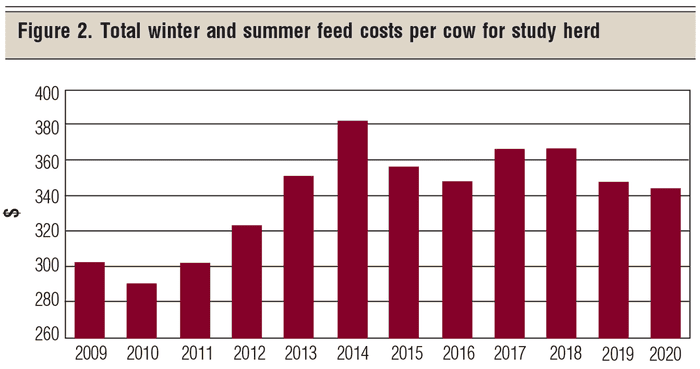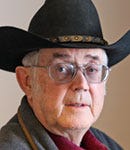Cash flow analysis for the current cattle cycle
A herd can cash-flow and not be profitable, and a herd can be profitable but not cash-flow. Both measures of a beef cow herd are critical and need to be addressed on a regular basis.
January 9, 2019

As a rancher takes his herd through each cattle cycle, he has to be concerned about two economic performance factors concerning his beef cow herd. One is the net cash flow associated with the beef cow herd. The other is the net economic profit generated by the beef cow herd.
A herd can cash-flow and not be profitable, and a herd can be profitable but not cash-flow. Both measures of a beef cow herd are critical and need to be addressed on a regular basis.
Over a complete cattle cycle, the goal of a beef cow herd is to generate an economic long-run profit. The reality is that some years the beef cow herd is more profitable than others. Most of my recent Market Advisor columns have focused around the economic profit question.
From a cash flow standpoint, the beef cow herd needs to cash-flow each and every year. If it doesn’t cash-flow in any given year, you will be asked to explain why to your banker. Your banker will ask what you are going to do differently this year. This Market Adviser series will focus on the net cash flow analysis of the beef cow business.
My study ranch
Over the years of working with my study rancher, we have assembled considerable production and economic information for his herd. I have assembled this information into a cattle cycle simulation model focusing on this typical eastern Wyoming-western Nebraska study herd. I have his permission to share this cash flow model’s output with my readers.
Over the last cattle cycle, this rancher has tried to run a perpetual 250-cow herd by annually holding back approximately 45 replacement heifer calves to be developed into replacement heifers.
He has his own pastureland for grazing the cow herd and replacement heifers. He has sufficient farm land to raise his own feed to winter the cow herd and feed his replacement heifers. He traditionally has been selling his calves at weaning.
To begin this analysis, it’s helpful to look back and see where you started. For example, Figure 1 presents the study herd’s inventory data collected for 2009.
Note the exposed data is based on bull turnout numbers in 2008. The rest of the data in Figure 1 lays out the rancher’s physical herd numbers for 2009. The 2009 animal exposed numbers are carried forward to the 2010 inventory worksheet.

We have this same herd inventory data for each year beginning in 2009 and running through 2018. I also have this production data projected for 2019 and 2020.
The ultimate goal is to use this database to project the most profitable way to run this cow herd through the next cattle cycle. At this point, we are still modeling the current cattle cycle.
Economic data used in analysis
Simulating this beef cow herd over the current complete cattle cycle has been a challenging job for both the rancher and me. We believe, however, that this effort will allow us to do a reasonably good job in evaluating this rancher’s alternative production strategies for the next cattle cycle.
Figure 2 presents the total annual feed cost per cow (winter and summer) assembled for this beef cow herd. These costs are based on local market prices for both farm-raised feeds and the going local pasture rental rates.

Since this rancher both runs cows and farms, the cow herd is being charged market prices for farm-raised feeds, and the feed-growing enterprises are credited with the market price of farm-raised feeds. This way, farming profits or losses are not allocated to the beef cow herd.
As pointed out in previous Market Adviser columns, long-run annual feed costs per cow have generally trended upward since 2009. Feed costs for this rancher have also trended upward through the current cattle cycle (see Figure 2). The statistical trend on this rancher’s feed cost is an increase of $5.60 per cow per year.
Heifer development costs
One of the bigger cost variables has been the total cost of developed replacement heifers (see Figure 3). Heifer development costs are made up of:
• The market value of the weaned heifer calf transferred into the heifer development enterprise.
• The cost of developing the heifer calf into a preg-checked heifer transferred into the cow herd. This is the cost of growing the heifers in the winter, summer grazing, breeding, preg testing, and adjusting for the open heifers.
The major difference in the annual heifer development cost is attributed to the varying annual market value of the weaned heifer transferred into the heifer development enterprise.
As the rancher and I were viewing and discussing Figure 3, we quickly raised the economic question of buying replacement females versus raising them. We fully plan on simulating this herd with purchased replacement heifers to study the economics of raised vs. purchased replacement heifers.

I also pointed out to this study rancher that other authors in this magazine have also raised a production question of the benefits of raising your own replacement heifers.
Family living draw
The family living draw is an important cash cost of running cows that is not an economic cost. This study ranch family has no one working off the ranch, so there is a partial family living draw allocated toward the beef cow herd.
This rancher farms as well as runs a beef cow herd. His family has set the share of the family living draw against the cow herd at $100 per cow, or $25,000 per year.
Fortunately, this ranch has no debt allocated to the cow herd, so there is no debt service charge allocated to the beef cow herd in this analysis. I will cover the impact of debt service cash flow in detail in a future article.
Figure 4 presents the study herd’s cash flow summary for this cattle cycle. This summary covers the current cattle cycle from 2009 through 2018, with our preliminary projections for 2019 and 2020.

I encourage my readers to spend some time reviewing Figure 4. Considerable follow-up discussion will occur in my next article. A significant cattle cycle story is unfolding. Stay tuned.
Hughes is a North Dakota State University professor emeritus. He lives in Kuna, Idaho. Reach him at 701-238-9607 or [email protected].
About the Author(s)
You May Also Like




.png?width=300&auto=webp&quality=80&disable=upscale)
